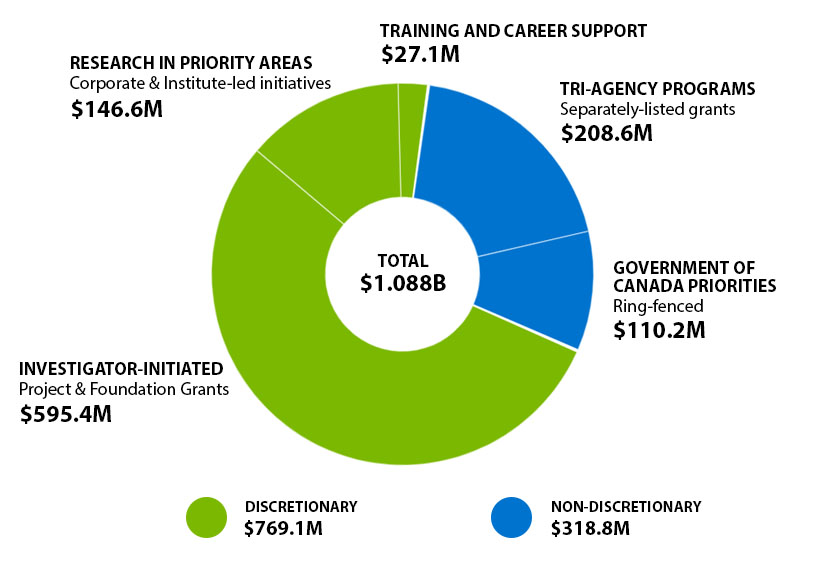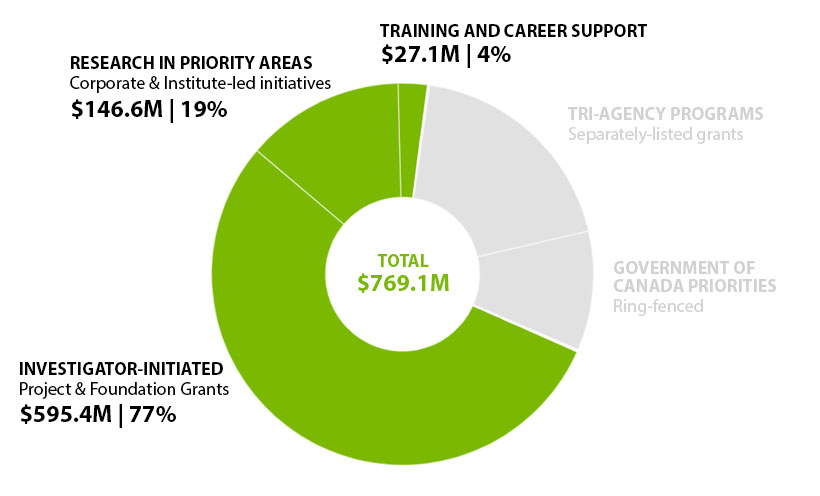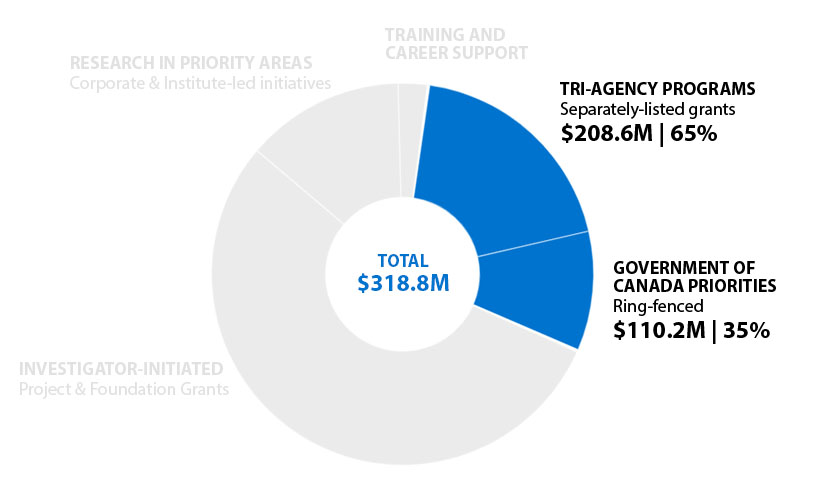CIHR Grants and Awards Expenditures: Fiscal Year 2018-19
In 2018-19, CIHR invested $1.088B in G&A. The G&A expenditures are divided into two main categories to reflect CIHR’s financial management investment flexibility in its programs: discretionary funding and non-discretionary funding.
Figure 1: Budget Overview

Figure 1 long description
| Discretionary | $769.1M |
|---|---|
| Investigator-initiated Project and Foundation Grants |
$595.4M |
| Priority-Driven Corporate and Institute-led initiatives |
$146.6M |
| Training and Career Support | $27.1M |
| Non-discretionary | $318.8M |
|---|---|
| Tri-Agency Program Separately-listed grants |
$208.6M |
| Government of Canada Priorities Ring-fenced |
$110.2M |
Discretionary Funding
The discretionary funding category represents the portion of funding over which CIHR has financial management and investment flexibility.
The discretionary funding category supports a variety of programs, including investigator-initiated research programs, training and career support programs, and research in priority areas.
For 2018-19, the discretionary funding category represented about 71% of the total G&A expenditures, or approximately $769.1M.
Of this $769.1M, CIHR invested $595.4M (or 77%) in investigator-initiated research programs, $146.6M (or 19%) in research in priority areas, and $27.1M (or 4%) in training and career support.
Figure 2: Discretionary Funding Investments

Figure 2 long description
| Discretionary | $769.1M |
|---|---|
| Investigator-initiated Project and Foundation Grants |
$595.4M |
| Priority-Driven Corporate and Institute-led initiatives |
$146.6M |
| Training and Career Support | $27.1M |
CIHR has the authority to determine which programs to support within the discretionary funding category. However, CIHR cannot change the proportion of its overall G&A budget assigned to this category, as the proportion assigned to non-discretionary funding is essentially fixed (see Fig. 3: Non-Discretionary Funding).
Non-discretionary Funding
The non-discretionary funding category of CIHR’s G&A budget can be further divided into Government of Canada Priorities (also known as Ring-Fenced Funds) and a funding envelope for Tri-Agency Programs (also known as Separately Listed Grants). CIHR’s investments through the non-discretionary funding portion of its G&A budget are prescribed by the Government of Canada. As a result, CIHR has very limited authority to use the funding for any purpose other than the one(s) prescribed.
For 2018-19, the non-discretionary funding category represented about 29% of the total G&A expenditures, or approximately $318.8M
Figure 3: Non-discretionary Funding Investments

Figure 3 long description
| Non-discretionary | $318.8M |
|---|---|
| Tri-Agency Program Separately-listed grants |
$208.6M |
| Government of Canada Priorities Ring-fenced |
$110.2M |
The Government of Canada Priorities funding envelope (nearly 35% of non-discretionary funding, and approximately 10% of the total CIHR G&A budget) supports strategic initiatives that have been announced in Federal Budgets, including long-standing initiatives, such as the HIV/AIDS and STBBI Research Initiative, as well as newer initiatives, such as Antimicrobial Resistance, post-traumatic stress (PTS) research and the Strategy for Patient-Oriented Research (SPOR).
As the name suggests, the Tri-Agency Programs funding envelope (approximately 65% of non-discretionary funding, and approximately 19% of the total CIHR G&A budget) supports tri-agency programs such as the Canada Research Chairs, Vanier Canada Graduate Scholarships, and Canada First Research Excellence Fund – among many others. These programs are designed to support all areas of research through collaborations between the tri-agencies—the Natural Sciences and Engineering Research Council (NSERC), the Social Sciences and Humanities Research Council (SSHRC), and CIHR—with each agency administering the funding for projects relevant to their specific mandate. For example, funding for a Canada Research Chair awarded to a researcher working in an area of health research would be managed and disbursed by CIHR.
- Date modified: